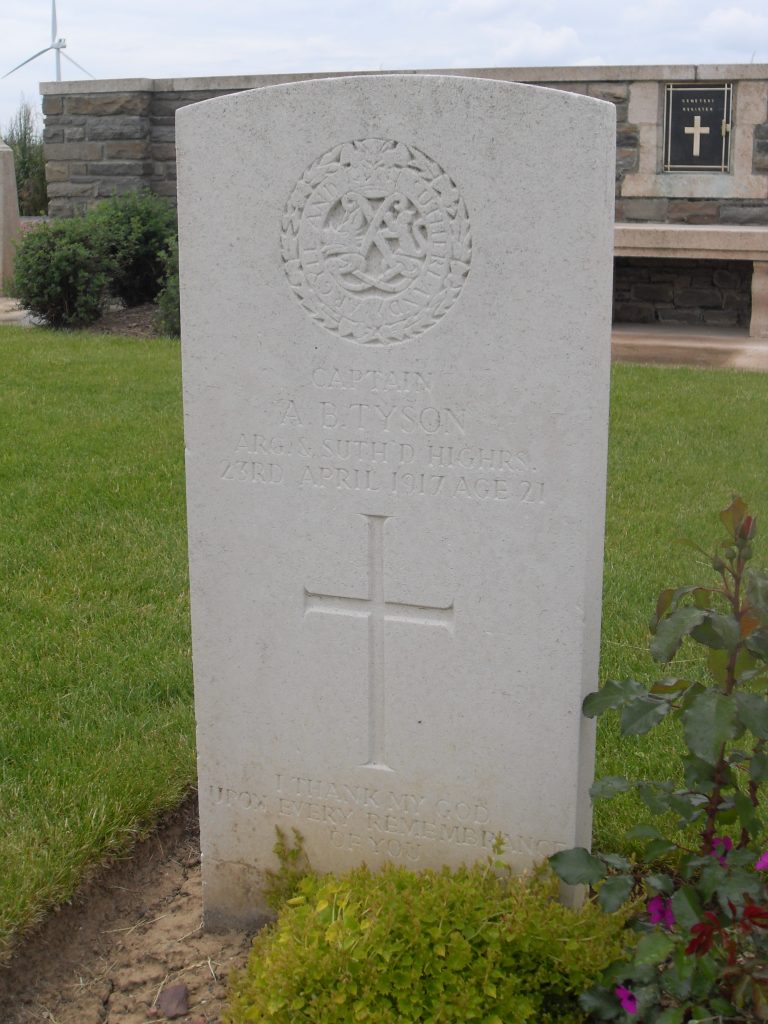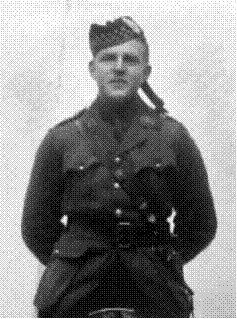Fact file:
Matriculated: Did not matriculate
Born: 23 January 1896
Died: 23 April 1917
Regiment: Argyll and Sutherland Highlanders
Grave/Memorial: Héninel-Croisilles Road Cemetery: II.B.1
Family background
b. 23 January 1896 at 92, Victoria Street, Monks Coppenhall, Crewe, Cheshire. Second son of the Reverend Henry Tyson (1864–1924) and Mrs Eliza Smith Tyson (née Baird) (1863–1943) (m. 1892). In 1901 and 1911 the family lived at All Saints’ Vicarage, Cheadle Hulme, Stockport, Cheshire (three servants), and Eliza moved to 14A, Holland Villas Road, Kensington, London, after her husband’s death.
Parents and antecedents
Tyson’s paternal grandfather, John Dawson Tyson (1825–1906), was a marine insurance broker, and founded the company of John D. Tyson and Co. with offices in Liverpool and London; the company eventually became part of the Bowring Group.
Tyson’s father was privately educated, and from 1884 to 1887 he read for a Pass Degree at Magdalen (MA 1891), the first of ten members of the Tyson family to study at the College. After graduating, he spent some time travelling abroad and then studied for the ministry at University College, Durham. He was ordained deacon in 1891 and priest in 1892, and after being Curate of Christ Church, in the centre of Monks Coppenhall, Cheshire, from 1891 to 1897, he chose to spend the rest of his professional life as Vicar of All Saints’ Church, Cheadle Hulme, Cheshire, a living that was worth £280 p.a. in a parish of 1,700 souls (5,000 by the time of his retirement). The Cheadle Hulme parish magazine described him as follows in its centenary edition (1963):
[He was] always assiduous in his pastoral work, he was truly the persona of the parish, the acknowledged leader of the whole community. He was, in the words of one who knew him well, a man of broad sympathy which came from wide and accurate scholarship and a charity which enabled him to see the point of view of other men, even those with whom he disagreed.
On the Sunday after his funeral, large crowds assembled at the parish church for evensong and no other services were held anywhere else in the village that evening. In autumn 1924 new oak choir stalls were dedicated in his memory and the main hall of the Parish Room – built in 1915 thanks to his efforts and exertions – was named the “Tyson Hall”.
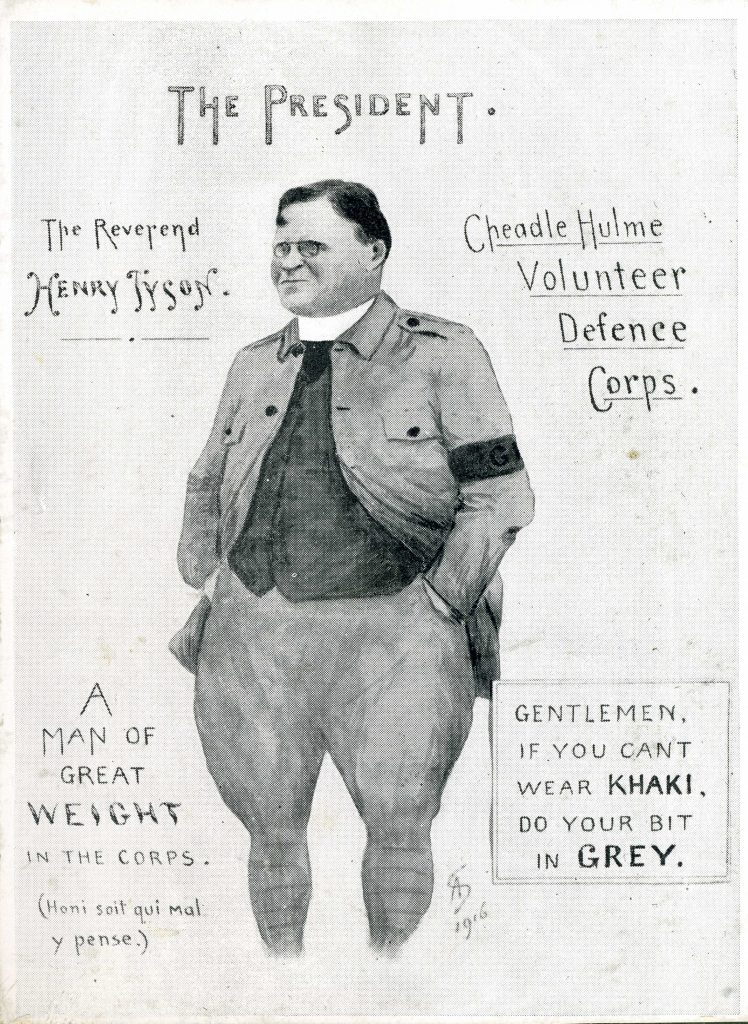
The Revd Henry Tyson (1864-1924) (1916)
(Photo courtesy of Donald Alexander Tyson; Photo © Donald Alexander Tyson).
Tyson’s mother, Eliza Smith Baird, was the daughter of Alexander Smith Baird (18321924 ), who in 1860 was appointed First Lieutenant in the 3rd Company of the Lanarkshire Artillery Volunteers and later the same year Captain, but this did not last long as he resigned his commission before the year was out. He was a partner in the firm of John Baird and Co. Commission Agents in Glasgow, but in the 1891 Census he describes himself as a wine merchant of Govan.
Siblings and their families
Brother of:
(1) John Dawson (later Sir John, KCIE, CSI, CBE) (1893–1976); married (1930 in Calcutta) Dorrice Alexander Yuill (1903–65) of Durban, South Africa; two daughters;
(2) Henry Alan Maurice (“Maurice”) (1897–1975); married (1924) Dorothy Allan Walker (1895–1959); three sons;
(3) Thomas Low (1902–78); married (1933) Dorothy Elizabeth Wilder (1904–67) of Toledo, Ohio; one daughter.
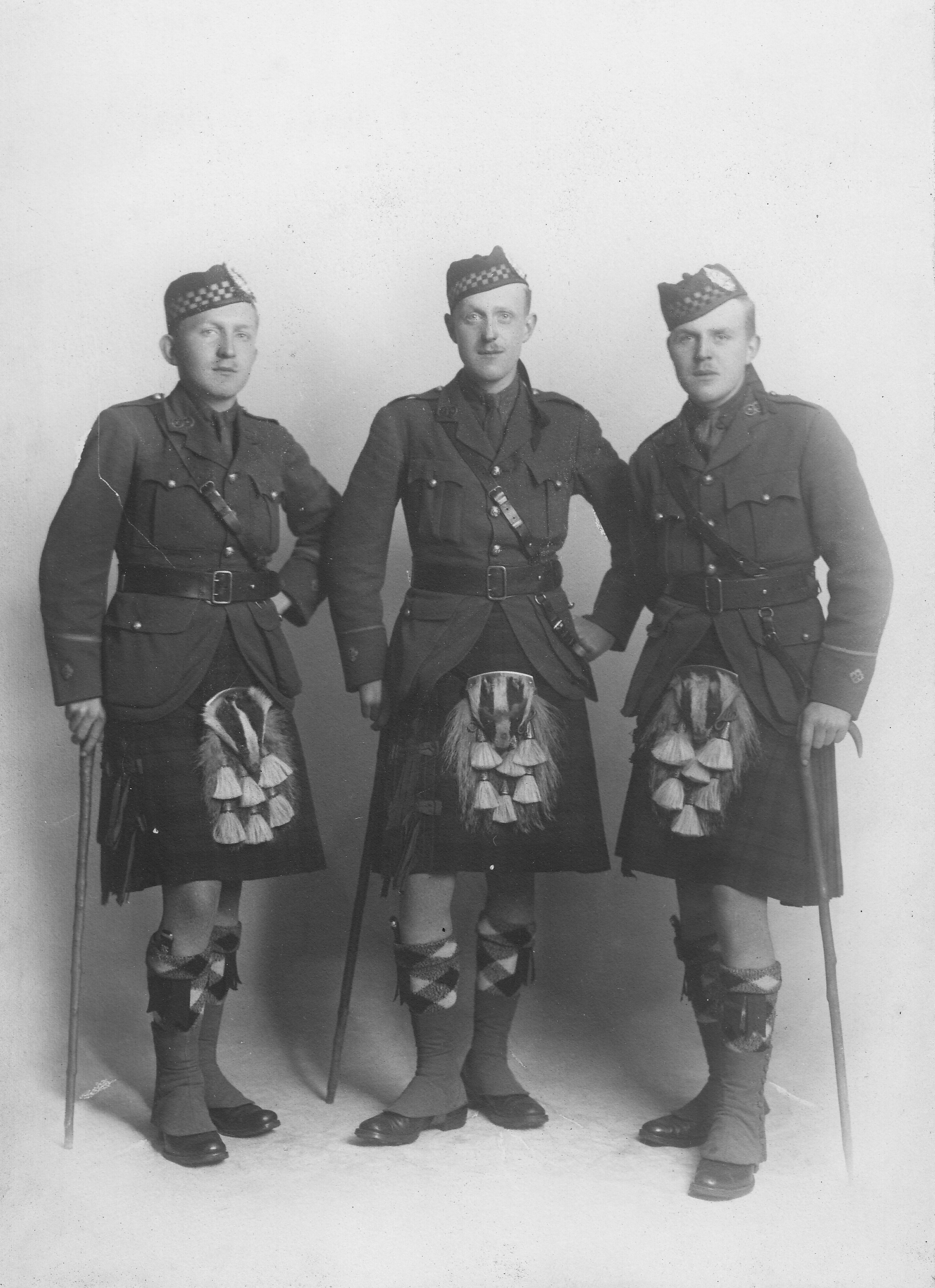
Three of the Tyson brothers (c.1915). Left to right: Henry Alan Maurice Tyson, John Dawson Tyson, Alexander Baird Tyson
(Photo courtesy of Donald Alexander Tyson; Photo © Donald Alexander Tyson)
John Dawson attended Aldenham School, Elstree, Hertfordshire, from 1904 to 1912 and was an undergraduate at Magdalen from 1912 to 1914 and also in the summer of 1919, when he completed a shortened war degree. While at Magdalen he became interested in rowing and in the Lent and Trinity Terms of 1914 he rowed in Magdalen’s second VIII, which performed extremely well in Torpids and Eights week and came fourth on the river in the former races – the highest that a second crew had ever been until the 1980s. He was also a friend of the Prince of Wales (who was an exact contemporary of his at Magdalen) and shared bagpipe lessons from Pipe Major with him. As a result, he became the “real subject of an excellent cartoon by an Oxford artist, which represents the Prince of Wales dancing a fling in Tyson’s upturned bath, to the strain of his bagpipes”.
On 15 August 1914, having been a cadet in the Oxford University Officers’ Training Corps, he was commissioned Second Lieutenant in the 4th (Extra Reserve) Battalion of the Argyll and Sutherland Highlanders (London Gazette, no. 28,918, 29 September 1914, p. 7,694); was confirmed in this rank in February 1915 (LG, no. 29,094, 9 March 1915, p. 2,377); and disembarked in France in February 1915. From June 1915 he developed serious rheumatism and often appeared before medical boards. He was promoted Lieutenant on 2 May 1916 and Captain on 18 February 1917. (LG, no. 29,688, 28 July 1916, p. 7,556; no. 30,326, 5 October 1917, p. 10,373). On 11 December 1917, while commanding ‘C’ Company of the 2nd (Regular) Battalion of the Argyll and Sutherland Highlanders, he, together with Lieutenant Dunley and Private Kent, was captured in front of the village of Passchendaele during a raid by the Germans while they were sheltering in a shell-hole. He spent his time as a prisoner of war in Limburg on the Lahn, Germany, and was repatriated on 6 December 1918. In 1920 he joined the Indian Civil Service and served – mainly in Bengal – from 1920 to 1947. From 1926 to 1927 he was Chief Presidency Magistrate of Calcutta; from 1927 to 1929 he was Secretary to the Agent of the Government of India in South Africa and Acting Agent in 1930; from 1930 to 1935, and also in 1938, he was Private Secretary to the Governor of Bengal (CBE in 1933), and was on two occasions present when an attempt was made to assassinate the Governor. In 1936 and from 1945 to 1947 he was an adviser to Cooch Behar State; in 1939 he was Secretary of the Government of India’s Communications Department; and from 1940 to 1945 he was Secretary of the Government of India’s Department of Education, Health and Lands (CSI 1945, KCIE 1947). From 1943 to 1945 he was President of the Himalayan Club. After his retirement he moved to South Africa, where he settled in Durban, his wife’s home town, but because he was never in sympathy with the policy of apartheid he remained a British subject. In Durban, he took a great part in the life of the Indian community and was for many years the Treasurer of the big Indian hospital there.
Henry Alan Maurice attended the Ryleys Preparatory School, Alderley Edge, Cheshire, and then Aldenham School, Elstree, Hertfordshire, from 1908 to July 1915 and was awarded an Exhibition in Classics at Magdalen in 1915. While at Aldenham, he served for three years in the Officers’ Training Corps and rose to the rank of Sergeant, and on 14 July 1915 he became a member of the Reserve of Officers. On 29 July 1915 he attested for the 4th (Extra Reserve) Battalion of the Argyll and Sutherland Highlanders, and on 30 July 1915 he was commissioned Second Lieutenant on probation in that Battalion on the strength of his previous military experience and training (London Gazette, no. 29,245, 27 July 1915, p. 7,447). He was confirmed in that rank on 9 June 1916 (LG, no. 29,619, 9 June 1916, p. 5,811); and disembarked in France on 8 July 1916 as an officer in the 14th (Service) Battalion of the same Regiment. He was seriously wounded by a rifle bullet at a range of 15 yards during the Battle of Bourlon Wood, near Cambrai, on 24 November 1917. While he was going forward to fill up a gap in the line, a bullet entered his left chest, skirted the side wall of his chest without injuring his ribs or lungs and came out at the posterior axillary wall. He arrived back in England on 30 November, mended fairly quickly, and was promoted Lieutenant on 11 December 1917 (LG, no. 30,426, 11 December 1917, p. 13,056). Henry Alan returned to his Battalion in May 1918. He reached the rank of Captain and was, for a while, aide-de-camp to the General Officer Commanding Scottish Command, working as an Intelligence Officer at Brigade headquarters.

Henry Alan Maurice Tyson, BA (c. 1916)
(Photo courtesy of Donald Alexander Tyson; Photo © Donald Alexander Tyson).
Having delayed his matriculation until 1919, Henry Alan Maurice studied at Magdalen until 1922, when he was awarded a 2nd class degree in Literae Humaniores. Because of his wound he was advised not to take up rowing, and he played soccer instead. From 1922 to 1923 he stayed at Oxford to improve his knowledge of French and German and then spent a year at Neuchâtel University, Switzerland. Having decided to become a schoolmaster, he taught for four terms at the newly founded Canford School, near Wimborne Minster, Dorset, before becoming an Assistant Master at St Paul’s School, where he worked from 1924 until 1952. Here he became Head of Modern Languages and Careers Master after World War Two; in 1935 he was appointed the School’s Surmaster (Deputy Head), and on two occasions he was Acting High Master. During World War Two he was a Captain in the Berkshire Home Guard and he retired to Colinton, a southern suburb of Edinburgh that looked out on the Pentland Hills. He died in Bexhill, Sussex.
Henry Alan Maurice’s three sons – Alan (later CBE) (1926–2000), John Baird (later OBE, MC) (1928–2014) and Donald Alexander (b. 1935) – all studied at Magdalen. Alan Tyson had a particularly distinguished career. He attended Rugby School from 1940 to 1945 and then, after two years of National Service in the Royal Navy, he became a Demy (= half a Fellow, i.e. a Scholar) at Magdalen, where he got a double First in Classics. In 1952, he was elected a Fellow of All Souls College, Oxford; from 1953 to 1957 he studied psychoanalysis at the London Institute of Psychoanalysis; and from 1957 to 1960 he practised as a lay psychoanalyst. During this period, he attracted the attention of James Strachey (1887–1967), who invited him to become a member of the editorial staff that was producing the 24-volume English edition of the works of Sigmund Freud, and in this capacity he translated Freud’s studies of Leonardo da Vinci and the psychopathology of everyday life. As a medical degree is necessary for psychiatric work in the National Health Service, he decided to study Medicine at University College Hospital from 1960 to 1965 and then did two years of internships at New End Hospital, New York. But from the 1950s, he had been collecting editions of late eighteenth-century and early nineteenth-century music and analysing them by means of the skills that he had learnt to apply to classical authors.
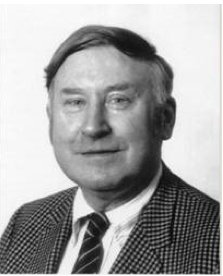
Alan Tyson, CBE (1926-2000).
Then, during his medical training, he became increasingly interested in musicology, the discipline for which he is now best known, and published his first research article in this field in 1961. By 1967, he had published a large number of internationally recognized publications on text-critical topics, and although, from 1968 to 1970, he was a Lecturer in Psychopathology and Developmental Psychology at the University of Oxford, he finally decided to give up medicine and psychoanalysis in order to concentrate on music. Using forensic methods that he had partly acquired during his medical studies, he became a leading world expert on the dating and chronology of the works of Beethoven, Clementi, Haydn and, in particular, Mozart, mainly via the analysis of paper types and watermarks. Over the years he published 13 books and 90 learned papers on musicology – plus a host of other writings. His three most famous books are: The Authentic English Editions of Beethoven (1963), Thematic Catalogue of the Works of Muzio Clementi (1967), and Mozart: Studies of the Autograph Scores (1987). From 1971 to 1994 he was a Senior Research Fellow at All Souls and he acted as its Sub-warden from 1978 to 1980. From 1973 to 1974 he was the James P.R. Reader in Bibliography; from 1977 to 1978 he was the Ernest Bloch Professor of Music at the University of Berkeley, California; in 1978 he was elected Fellow of the British Academy; and in 1989 he was awarded a CBE. In 1998 his friends and colleagues, of whom he had many, presented him with a Festschrift.
John Baird Tyson did National Service as a Lieutenant from 1947 to 1949 in the Argyll and Sutherland Highlanders, mainly in Malaya where he was awarded the MC on 13 December 1949. He then studied Geography at Magdalen from 1949 to 1952 (MA 1958), but in mid-course he was recalled for military training in the Scottish mountains and put on 24 hours’ notice to be sent to Korea – which, in the event, did not happen. In 1952 he led the Oxford University Scientific Expedition to Tehri-Garhwal, a large hill state in Uttarakhand, India, and in 1953 the expedition to West Nepal, which was just starting to open its borders. In 1954 he was an instructor at the Outward Bound Mountain School, Eskdale, Cumbria, under the well-known mountaineer Eric Shipton, CBE (1907–77). In 1955 he filled in a temporary vacancy at Rugby School; from 1956 to 1958 he was an Assistant Master at Christ’s Hospital, Horsham, West Sussex; and from 1958 to 1975 he was back at Rugby, first as an Assistant Master and latterly as a House Master. In April 1957 he married Phebe. During his time at Rugby he made three three-month expeditions to central Nepal in order to explore and map the Kanji Himal mountain range; John’s map was published in the Geographical Journal by the Royal Geographical Society (RGS) in September 1967 as a fold-out accompaniment to an article. From 1975 to 1977 he was Headmaster of Yangchenphug School, Thimphu, Bhutan, and adviser on education to Bhutan as a whole; from 1978 to 1982 he was Headmaster of Reed’s School, Cobham, Surrey; and from 1983 to 1989 he was Headmaster of Budhanilkantha School, Kathmandu, Nepal’s premier school. He received the Ness Award of the RGS in 1963, the Nepalese Order of Prasiddha Prabal Gorkha Dakshin Bahu in 1987, and the OBE in 1988.
Donald Alexander Tyson studied German and Russian at Magdalen from 1956 to 1959 and also went into school-teaching. From 1960 to 1961 he was an Assistant Master at King’s School, Grantham, Lincolnshire; from 1961 to 1968 he was an Assistant Master at King’s College, Taunton, Devon; and from 1968 to 1995 he was on the staff of Lancing College, Sussex, where he was Head of Russian and German from 1985 to 1995.
Thomas Low Tyson, Alexander Baird’s youngest brother, was educated at Aldenham School, Elstree, Hertfordshire, from 1914 to 1921, and read History at Magdalen from 1921 to 1924, when he was awarded a 2nd class degree. He took his MA in 1928 and became Chairman of Invincible Policies Ltd and Managing Director of Trafalgar Insurance Co. Ltd.
Education
Tyson attended Cheadle Hulme High School for 18 months and then Ryleys Preparatory School, Alderley Edge, Cheshire, before attending Aldenham School, Elstree, Hertfordshire, from 1908 to 1914, where he played cricket for his House and proved to be a fair shot. In early 1914, he represented the School at the Public Schools Boxing Tournament at Aldershot. In October 1914 he was accepted at Magdalen as a Commoner for October 1915, but he did not matriculate.
War service
Tyson had been in the Officers’ Training Corps (OTC) at Aldenham for three years and became a Platoon Sergeant when war broke out; he was in camp with the OTC at the time. So on 6 August 1914 he applied for a Territorial Commission and on 15 August 1914 he was gazetted Second Lieutenant in the 4th (Extra Reserve) Battalion of the Argyll and Sutherland Highlanders, the Regiment in which his older brother John Dawson was already serving (London Gazette, no. 28,910, 22 September 1914, p. 7,490). On 12 August and again on 11 September 1914 he successfully applied for a Commission in the Regiment’s Special Reserve of Officers and from about 18 February to 16 June 1915, he attended the Royal Military College (Sandhurst), where he became the senior Sergeant of his Company. On 23 February 1915 he resigned his Territorial Commission (LG, no. 29,080, 23 February 1915, p. 1,842) and on 15 June 1915 he was given a Regular Commission as a Second Lieutenant in the 2nd (Regular) Battalion of the Regiment in which he was already serving (LG, no. 29,193, 17 June 1915, p. 5,760). The 2nd Battalion had been in France since 14 August 1914 – at first as part of 19th Brigade, in the 6th Division. But on 31 May 1915 the 19th Brigade was transferred to the 27th Division, and on 19 August 1915 to the 2nd Division in place of the 4th Guards Brigade when that formation became part of the newly created Guards Division. Although Tyson’s medal card indicates that he disembarked in France on 8 July 1916, his Battalion’s War Diary indicates that he did not join the 2nd Battalion at the front until 1 October 1915, when it was in billets at Annequin, five miles east-south-east of Béthune, after losing 15 officers and 315 other ranks (ORs) killed, wounded or missing during the attack near Cambrin (Battle of Loos) on 25 September 1915. From 6 to 16 October, the Battalion was in billets at Béthune before spending three days in the trenches near Cambrin, just north of Annequin. This relatively peaceful pattern was repeated throughout October and November until, on 22 November 1915, a large mine was exploded 30 yards in front of the Battalion’s trenches, whereupon its crater was occupied by a Grenadier Battalion and Tyson’s Battalion, who held it against counter-attack.
On 23 November 1915, the Battalion marched through Béthune for a fortnight’s rest in billets at Mont-Bernanchon and Le Touret, just to the north-west of Béthune; on 28 November, it was moved from 19th Brigade in the 6th Division, to 98th Brigade in the 33rd Division; and on 6 December, it was sent to the trenches at Festubert, five miles east-north-east of Béthune, where everything was waterlogged. The Battalion War Diary remarked: “Trenches and Communicating trenches full of water and sticky mud, troops wading to [the] waist in water and mud.” The Battalion remained in the area of nearby Cuinchy and La Bassée (trenches), Béthune, Annequin, Le Quesnoy and Beuvry (billets) until July 1916, while the Germans intensified their shelling and increased the Battalion’s casualty rate over the course of those six months. On 2 January 1916, 14 men of the Battalion were buried alive by very heavy shell fire; on 23 March, heavy bombardment by German Minenwerfer killed an officer and seven ORs, three of whom were digging out comrades who had been buried by shell fire; between 24 and 28 May the Battalion was heavily mortared and shelled; and while in the trenches at Cuinchy between 11 and 21 June, the Battalion’s Commanding Officer was killed by shell fire.
On 8 July 1916, the Battalion began to edge its way southwards, towards the battlefields of the Somme, via Robecque, Coisy (9–12 July) and Méaulte (13/14 July), until it bivouacked for the night of 14/15 July on the southern edge of Fricourt Wood, in readiness for the start of the Battle of Delville Wood (15 July–3 September 1916). But when, at 09.00 hours, two Brigades of the 33rd Division attacked eastwards, with 100th Brigade on the right and 98th Brigade on the left, in the direction of the Switch Line and Martinpuich from a position between Bazentin-le-Petit and High Wood, Tyson’s 2nd Battalion was kept in reserve, back in Mametz Wood. Consequently, they suffered very few casualties, unlike their comrades, who were enfiladed by such fierce machine-gun fire that they were forced to withdraw. When the Division repeated its attack on 20 July, the 2nd Battalion was once more kept in reserve in the trenches north of Bazentin-le-Petit, and on the following day it was moved back to billets in Dernancourt until 6 August, when it returned to the trenches in Mametz Wood and thence, on 13 August, to the trenches in High Wood. Then, at 14.25 hours on 18 August, Tyson’s Battalion attacked the German trenches within High Wood, using 30 burning oil drums and two flame-throwers, none of which proved very effective, and the attack failed at a cost of eight officers and 181 ORs killed, wounded or missing. From 19 to 26 August the Battalion camped in bivouacs in Fricourt Wood, on 26 August it returned to the trenches, and on 27 and 28 August it attacked a German strong-point.
On 31 August the Battalion moved to billets in Dernancourt, a village on the River Ancre just to the south of Albert, and spent all of September moving around – presumably to toughen up its replacements by means of route-marches. By the end of that month, when the Battalion was preparing to return to the trenches, its strength had risen to 25 officers and 680 ORs, but as the carefully prepared list of officers to be found in the War Diary simply notes that Tyson is “instructing at Le Touquet”, we do not know to what extent he had taken part in the events of the preceding three months. He remained away on instructional duties at Le Touquet and then at No. 1 Training Camp, Étaples, until February 1917, and so missed a long stint in the trenches near Flers, Lesboeufs, and the Transloy Ridge, during the closing phases of the Battle of the Somme.
Tyson was promoted Lieutenant with effect from 27 December 1916 (London Gazette, no. 29,910, 19 January 1917, p. 810) and Acting Captain with effect from 11 February 1917 when he assumed command of a Company (LG, no. 30,002, 27 March 1917, p. 3,014), and he had certainly returned to the Battalion by 28 February 1917 since the War Diary lists him then as the Commanding Officer of ‘B’ Company. In the first week of March, the Battalion was in the trenches at Cléry-sur-Somme, just to the north-west of Péronne, and it spent the rest of March training, mainly near Sailly-Laurette on the River Somme due south of Albert, until by 31 March 1917 its strength had risen to 36 officers and 891 ORs. In the first week of April the Division moved northwards to the Arras area, and transferred from XV Corps, commanded by General Sir Henry Sinclair Horne (1861–1929) to XVIII Corps, commanded by General Sir Ivor Maxse (1862–1958).
The Second Battle of Arras began on 9 April, and on 12 April the Battalion moved forward to Boisleux-au-Mont (see G. Holmes and J.C. Tredgold). On 16 April it was near Hénin-sur Cojeul; from 17 to 19 April it was in the support trenches of the old Hindenburg Line; and from 20 to 22 April it was in Brigade Reserve. But on the latter date it moved to the front line, and on 23 April 1917, when the Battle of Arras became the Second Battle of the Scarpe, both the 98th and 100th Brigades took part in the attack by the 33rd Division on the high ground overlooking the village of Fontaine-lès-Croisilles and the nearby Hindenburg Line, close to the River Serisée. Tyson was leading ‘B’ Company on the left of a two-company attack when it was held up temporarily by machine-gun fire from a German strong-point, and he was killed in action, aged 21, while encouraging his men to dig in before resuming the attack. After the attack, which was not successful, it was estimated that the Battalion’s casualties amounted to 14 officers and 254 ORs killed, wounded or missing.
According to his obituary in the Aldenhamian of July 1917: “Many a tribute has been received to his keenness, his constant cheerfulness, and the affection he inspired in all with whom he came in touch”; and an obituary that appeared in a Cheshire newspaper said of him: “To those who knew him, his ever-broadening outlook, his love of justice, his quickness to see the needs of others, and his high courage all gave promise of a vigorous and knightly manhood.” He is buried in Héninel-Croisilles Road Cemetery (south-south-east of Arras), Grave II.B.1. The inscription reads: “I thank my God upon every remembrance of you” (Philippians 1:3). In August 1919, a memorial stained-glass window was installed in All Saints’ Church, Cheadle Hulme; on 29 May 1921, his father dedicated the Cheadle Hulme War Memorial. Tyson left £770 14s 9d.



All Saints Church, Cheadle Hulme, Tyson Memorial Window
Courtesy Mike Berrell
(© Mike Berrell)
Bibliography
For the books and archives referred to here in short form, refer to the Slow Dusk Bibliography and Archival Sources.
Printed sources:
[Untitled Note], The Aldenhamian, no. 141 (April 1913), p. 247.
[Anon.], ‘Oxford Letter dated 28 May 1914 [re. J.D. Tyson], The Aldenhamian, no. 145 (July 1914), pp. 374–5.
[Thomas Herbert Warren], ‘Oxford’s Sacrifice’ [obituary], The Oxford Magazine, 35, no. 19 (18 May 1917), p. 255.
[Anon.], ‘Captain Alexander Baird Tyson’ [obituary], The Times, no. 41,502 (12 June 1917), p. 4.
[Anon.], ‘Alexander Baird Tyson’, The Aldenhamian, 15, no. 3 (no. 154) (July 1917), p. 58.
[Anon.], ‘Sir John Tyson’ [obituary], The Times, no. 59,766 (27 July 1976), p. 14.
[Anon.], ‘Obituary: Sir John Tyson’, The Aldenhamian, no. 332 (October 1976), pp. 38–9.
Dr J.C.P. Grey, ‘Obituary: T.L. Tyson’, The Aldenhamian, no. 338 (October 1978), pp. 38–9.
McCarthy (1998), pp. 50, 75.
[Anon.], ‘Alan Walker Tyson, CBE, FBA’ [obituary], The Times, no. 66,984 (14 November 2000), p. 25; reproduced in The Magdalen College Record (2001), pp. 196–97.
Maynard Solomon, ‘Alan Walker Tyson, CBE FBA’ [obituary], The Guardian, no. 47,955 (14 November 2000), p. 24.
Oliver Neighbour, ‘Alan Walker Tyson, 1926–2000’, Proceedings of the British Academy, 115 (2002), pp. 367–82.
[Anon.], ‘John Baird Tyson, OBE, MC’ [obituary], The Magdalen College Record (2014), pp. 282–3.
Archival sources:
MCA: Ms. 876 (III), vol. 3.
MCA: P347/P1/1 (Photograph album kept by Henry Alan Maurice Tyson [1897–1975]; E. 1919–22).
MCA: P347/Ms. 1/1 (Donald Tyson, ‘The Revd Henry Tyson [1864–1924]’ [January 2010], 2 pp.).
MCA: P347/Ms. 1/2 (Donald Tyson, ‘Henry Alan Maurice Tyson’ [Autumn 2009], 6 pp.).
WO95/1365.
WO95/2426.
WO339/24044.
WO339/38282.
WO339/54086.

